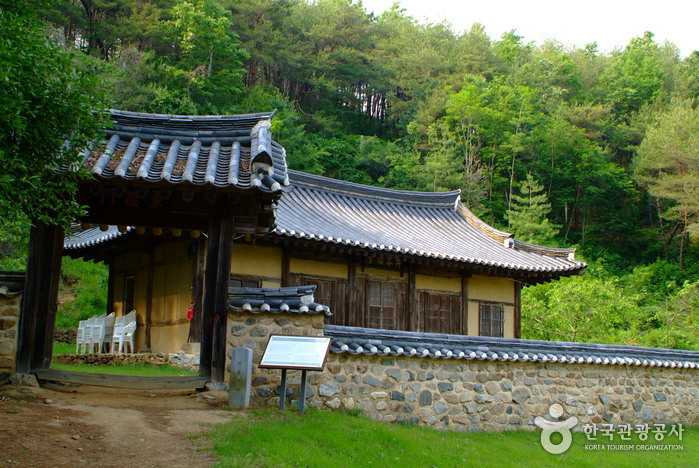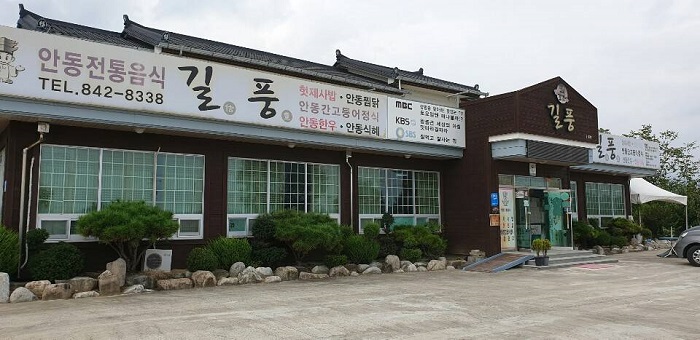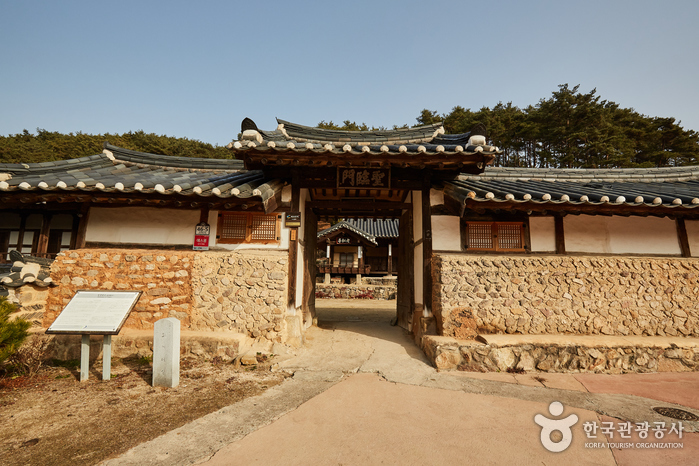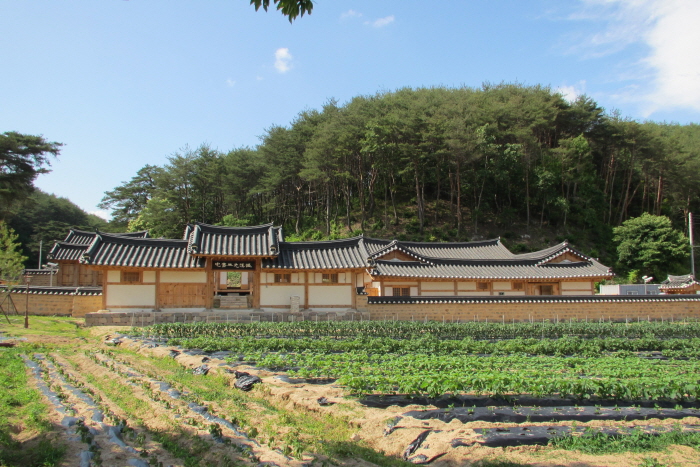Le Village d’Art de Jirye (지례예술촌)
18.1Km 2024-07-08
769, Bakgok-ri, Imdong-myeon, Andong-si, Gyeongsangbuk-do
+82-54-852-1913
Le village d’art de Jirye à Andong est le l’endroit par excellence où vous pourrez vivre une experience de la culture coréenne traditionnelle. Le site a été désigné comme village artistique en 1990. Le site propose de nombreuses activités liées aux traditions en Corée et à l'artisanat.
Gilpung (길풍)
18.7Km 2021-03-23
8, Nabau-gil, Andong-si, Gyeongsangbuk-do
+82-54-841-9967
It is a clean and delicious restaurant, selected by the Korea Tourism Organization, where you can taste Andong's local food. This restaurant's signature menu is Andong braised chicken. This Korean dishes restaurant is located in Andong-si, Gyeongsangbuk-do.
Andong Hanji (안동한지체험)
18.8Km 2019-04-10
36-1, Sosan-ri, Pungsan-eup, Andong-si, Gyeongsangbuk-do
+82-54-858-7007
Andong Hanji, situé à l’entrée du village Hahoe, zone préservant la tradition et la coutume coréenne, a fait de son mieux pour fabriquer du papier traditionnel coréen. Le papier coréen d’Andong est fait à partir de papier de bois de mûrier coréen et d’eau pure. Andong Hanji est très fière de maintenir une qualité exceptionnelle et la plus haute capacité de production de papier traditionnel coréen.
* Produits
Approximativement 60 papiers différents incluant du papier à dessin fait de pulpe de mûre, du papier à calligraphie, du papier à dessin basique, du papier fenêtre, du Jungji (papier), de l’Unyongji (papier), du Piji (papier) pour papier peint, du papier coréen à multiples épaisseurs, du papier pour sol, du papier à livre, du papier brocardé pour les intérieurs de première qualité, du numéro 100 et 120 pour les peintres professionnels, et du papier couleur coréen utilisé pour l’artisanat ainsi que du papier d’emballage sont fabriqués ici.
* Réception du papier coréen
Le papier traditionnel coréen de haute qualité est fourni comme suit : le papier à dessin à la seconde grotte Seokguram dans le temple Donghwasa, le Samyukji (papier) au temple Bulguksa à Gyeongju, le « papier de peinture orientale » à la faculté des Beaux-Arts d’Andong National University, l’Oebalbaekdaksunji (papier) à l’Institut de Recherche pour la Préservation des Propriétés Culturelles du Papier, et le Baekdaksunji (papier) au Centre de Conservation Jung-Jae. Présentement, les diplômes d’honneur et les lettres de nomination sont fournies à l’Agence Nationale de Police.
Daebanggwangbulhwaeomgyeong (soutra Avatamsaka) (Trésor National 196) – retranscrit sur du papier de la periode de Silla Unifié, aussi utilisé pour le Mugujeonggwan Daedaranigyeong (soutra Dharani de pure lumière), affiché au musée d’Arts Ho-Am, a été restauré ici. En décembre 2001, le soutra restauré a été fourni à l’Administration de l’Héritage Culturel de Daejeon. En outre, des poupées de papier de mûre et des images faites de papier coréen traditionnel sont affichées dans la salle VIP de Korean Air à l’aéroport international d’Incheon.
La Forêt Hakgasan Urae (학가산자연휴양림)
18.9Km 2020-12-08
San 60, Urae-ri, Bomun-myeon, Yecheon-gun, Gyeongsangbuk-do
+82-54-652-0114
La forêt Hakgasan Urae est située au mont Hakgasan (882 mètres d'altitude) à Yecheon dans la province de Gyeongsangbuk-do. Elle est facilement accessible par la route qui longe la rivière.
Vous y trouverez des cabanes en bois pour y passer la nuit. Un sentier mène au sommet du Mont Kakgasan à environ deux heures de marche. On y trouve aussi un site pour le feu de camp, une scène de spectacle, un terrain de jeu pour enfants, une salle de sport et un parc aquatique.
Songgyehyeon [Korea Quality] / 송계헌 [한국관광 품질인증/Korea Quality]
19.1Km 2021-03-25
332, Byeongsan-gil, Andong-si, Gyeongsangbuk-do
This hanok (traditional Korean House) lies only 500 m away from Andong’s Byeongsanseowon Confucian Academy. Byeongsanseowon Confucian Academy is one of the Confucian academies (Joseon-era places of learning and veneration of Confucian scholars) registered as a UNESCO World Heritage, and is particularly known for its beautiful harmony with the surrounding nature. Songgyehyeon likewise faces the Nakdonggang River to the front, and a 330 m-high mountain to the back, displaying the characteristic harmony of hanok with nature.
The house was named Songgyehyeon by the owner, who wanted to build a house made out of pine trees (“song”). The entire house is offered for rent, which makes it ideal for families and groups. Songgyeheon follows a strictly traditional structure of hanok, as evident in its hipped-and-gable roof, but its interior is equipped with comfortable modern facilities. The house includes both bedrooms and Korean-style ondol (under-the-heating system) rooms. One of the three bedrooms available has a queen-sized bed, while the remaining two are equipped with comfortable mats. The common space, spacious enough to host a group, has a high ceiling dominated by exposed beams. The kitchen is equipped with cooking equipment like refrigerator, gas stove, microwave oven, and utensils for guests to cook their own food. The owner of the house also enthusiastically provides detailed information on Andong’s many tourist sites.
Ecole confucianiste de Byeongsanseowon [Patrimoine Mondial de l'UNESCO] (병산서원)
19.5Km 2022-12-30
30, Byeongsan-ri, Pungcheon-myeon, Andong-si, Gyeongsangbuk-do
82-54-858-5929
Byeongsan Seowon est une école fondée par des savants confucianistes coréens en hommage à Yu Seong-Ryong (1542-1607), célèbre érudit qui jouissait d’une très haute réputation pour sa vertu et ses savoirs. Actuellement, cet établissement abrite sa plaque commémorative.
En 1863, le roi de la dynastie Joseon a doté cet établissement d’une autorité en tant que Saek Seowon, école exempte de toute taxe et de tout labeur en lui fournissant une plaque écrite par le roi, des livres, un terrain et des esclaves.
En 1868, un décret de Heungseon Daewongun (1820-1898, politicien de la famille royale de la dynastie Joseon) a aboli les écoles confucéennes ; Byeongsan Seowon est un des 47 établissements de ce type dans toute la Corée du Sud, et un des deux dans la ville d’Andong, à avoir pu y échapper.
Située devant le fleuve Nakdong et entourée par la montagne Byeonsan comme d’un paravent, cette école offre un très joli paysage.
Nosongjung Head House
19.7Km 2021-04-09
46-5, Onhyejungma-gil, Dosan-myeon, Andong-si, Gyeongsangbuk-do
+82-10-2065-3749
Nosongjeong, also called the “Placenta Chamber of Yi Hwang” (pen-name: Toegye, 1501-1570), is named after the pen-name ‘Nosong’ of Yi Hwang’s grandfather Yi Gye-yang. It is said that Yi Gye-yang abandoned his government position after he fell victim to the Gyeyujeongnan Suppression (a coup d’état instigated by Suyang Prince, who became King Sejo of Joseon, in 1455) and returned to his hometown in Bonghwa, where he devoted himself to teaching students. He built the house in its current location by a coincidence of saving a monk. The Placenta Chamber of Yi Hwang, which is situated deep in the house, consists of an Ondol (Korean floor heating) Room and a small numaru (upper floor) with a unique design. The gate bears a signboard with the word ‘Seonglimmun’ written by Hakbong Kim Seong-il (a direct disciple of Yi Hwang), which derives from the fact that the mother of Yi Hwang, Chuncheon Park, had a conception dream about Confucius entering the main gate with his disciples. Nosongjeong has an Ondol room in the west, with a numaru and a maru (wooden floor) in the east, which could accommodate 20 to 30 students. The signboard of Noseongjeong is believed to have been written by Han Seok-bong (a leading calligrapher of the mid-Joseon period). The structure of Nosongjeong is considered an invaluable resource for studies on the principles of building a half-hipped roof. The shrine is situated east of Nosongjeong, between which there was a juniper aged over 400 years from which the name of Nosongjeong was originated as people called the juniper as an old (no) pine (song). However, the original juniper has been replaced by its younger juniper tree with an umbrella shape of the top.
On-gye Jongtaeg (Sambaegdang) / 온계종택 삼백당
20.0Km 2025-03-04
20, Onhyejungma-gil, Andong-si, Gyeongsangbuk-do
+82-10-2988-3435
Ongyejongtaek Sambaekdang is a hanok restored on the site where Ongye Yihae, older brother of Toegye Yi Hwang, used to live. Being the headquarters of the rightoue army against the Japanese, the house was burned by the Japanese military authority in 1896 but restored with support from the government and others, and it was finally completed in May 2011. It is the 500-year old chestnut tree, symbol of the village, which welcomes guests first. The house itself is not old but the atmosphere of the family dominates the building with dignity. Small decorations such as a wooden table, floor cushions, and mother-of-pearl furniture pieces are all nice to look at. There are 7 rooms altogether with bathrooms or air conditioners depending on the room size. There are a shared shower facility and a laundromat outside the rooms, with shared kitchen, warehouse, and a big floor. Cooking is not allowed in the rooms but outdoor barbecue facilities are available for a group of 10 or more who inquire in advance. Tea ware pouch making or Hanji craft programs are conducted based on the reservation at a charge. In the village where the house is located, there are several historic and natural sites such as Nosongjeongjongtaek where Toegye Yihwang was born, Nongamjongtaek, Toegyejongtaek, Dosanseowon Confucian Academy, Advanced Center for Korean Studies, Cheongryangsa Temple, and Dosan Spa.



![Songgyehyeon [Korea Quality] / 송계헌 [한국관광 품질인증/Korea Quality]](http://tong.visitkorea.or.kr/cms/resource/42/2706142_image2_1.jpg)


 Français
Français
 한국어
한국어 English
English 日本語
日本語 中文(简体)
中文(简体) Deutsch
Deutsch Español
Español Русский
Русский